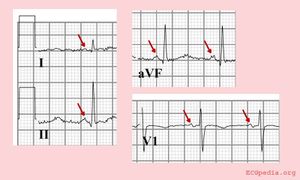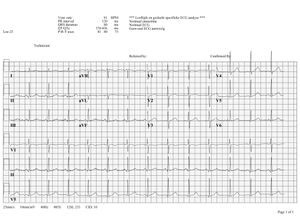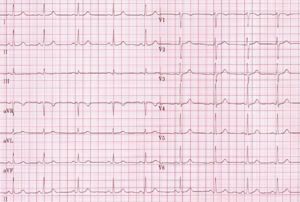P Wave Morphology: Difference between revisions
Jump to navigation
Jump to search
mNo edit summary |
mNo edit summary |
||
| Line 34: | Line 34: | ||
If the p-wave is enlarged, the [[Chamber_Hypertrophy_and_Enlargment#Left_atrial_enlargement|atria are enlarged]]. | If the p-wave is enlarged, the [[Chamber_Hypertrophy_and_Enlargment#Left_atrial_enlargement|atria are enlarged]]. | ||
If the P wave is inverted, it is most likely an [[atrial rhythm]] not originating from the sinus node. | If the P wave is inverted, it is most likely an [[ectopic atrial rhythm]] not originating from the sinus node. | ||
{{clr}} | {{clr}} | ||
Revision as of 17:56, 1 February 2009
| «Step 4:Heart axis | Step 6: QRS morphology» |
| Author(s) | J.S.S.G. de Jong, MD, A. Bouhiouf, Msc | |
| Moderator | J.S.S.G. de Jong, MD | |
| Supervisor | ||
| some notes about authorship | ||
The p wave morphology can reveal right or left atrial stretch.
The P-wave morphology is best determined in leads II and V1 during sinus rhythm.
The normal P wave
| Characteristics of a normal p wave:[1] |
|---|
|
Elevation or depression of the PTa segment (the part between the p wave and the beginning of the QRS complex) can result from Atrial infarction or pericarditis.
If the p-wave is enlarged, the atria are enlarged.
If the P wave is inverted, it is most likely an ectopic atrial rhythm not originating from the sinus node.


